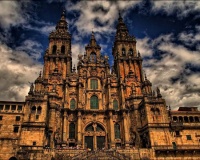Cathedral of Santiago de Compostela (1211 AD)
The End of the Journey for Pilgrims
When Aymeric Picaud published the fifth chapter of his Liber Sancti Jacobi in 1140, he may have struggled to believe that his text – widely regarded as the first travel guide ever written – would still form a point of reference for pilgrims on the Camino de Santiago some nine centuries later. Santiago de Compostela Cathedral, or Catedral de Santiago de Compostela, located in Galicia in north-western Spain, is the reputed burial place of the patron saint of Spain, St. James (Santiago). For more than 1,000 years the cathedral has been a place of pilgrimage – it is estimated that a quarter of all 14th century Europeans made the hazardous and debilitating journey. Today, pilgrims come from all corners of the planet – an estimated 150,000 made the trip last year – and their reasons for undertaking the pilgrimage are as varied as their nationalities. For many, the journey is a Christian pilgrimage, while for others it is purely spiritual, often made at a difficult juncture in someone’s life. Others treat it merely as a personal challenge, an opportunity to immerse themselves in Spanish history and culture, or simply as a chance to take in some of Europe’s most spectacular scenery. Generally, the journey itself is one of transcendence – an opportunity for people of disparate cultures to gain mutual understanding and spiritual growth.
